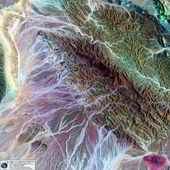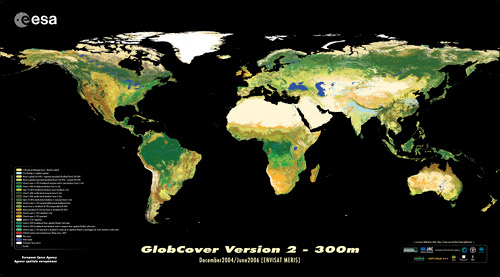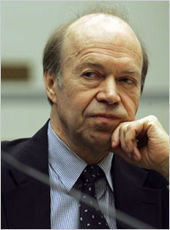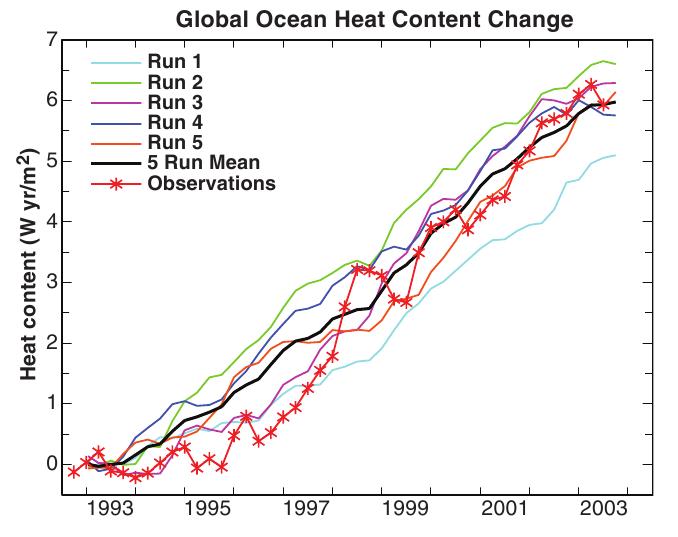In a new report, scientists used seven different climate models to assess human induced land cover change (LCC) at regional and global scales. The first results from the LUCID (Land-Use and Climate, IDentification of robust impacts) intercomparison study by Pitman et al. show no agreement among the models. This study indicates that land cover change is "regionally significant, but it is not feasible to impose a common LCC across multiple models for the next IPCC assessment." In other words, this important factor is missing from current models and scientists are at a loss as to how to add it.
The study, soon to be published in Geophysical Research Letters, performed the type of analysis that was recommended in the 2005 National Research Council report on how to improve climate model accuracy. The results were both as expected, LCC proved to be an important missing factor, and unexpected in that none of the seven models tested yielded the same results. This throws modelers into a quandary regarding how to proceed. Here is the abstract of the paper by A. J. Pitman et al.:
"Seven climate models were used to explore the biogeophysical impacts of human induced land cover change (LCC) at regional and global scales. The imposed LCC led to statistically significant decreases in the northern hemisphere summer latent heat flux in three models, and increases in three models. Five models simulated statistically significant cooling in summer in near-surface temperature over regions of LCC and one simulated warming. There were few significant changes in precipitation. Our results show no common remote impacts of LCC. The lack of consistency among the seven models was due to: 1) the implementation of LCC despite agreed maps of agricultural land, 2) the representation of crop phenology, 3) the parameterisation of albedo, and 4) the representation of evapotranspiration for different land cover types. This study highlights a dilemma: LCC is regionally significant, but it is not feasible to impose a common LCC across multiple models for the next IPCC assessment."One of the reasons that the researchers are concerned is that, though LCC has significant effect on models in the regions where the change occurs they failed to find a long distance connection that would influence climate globally. According to Roger Pielke Sr., Emeritus Professor of Atmospheric Science at Colorado State University and Senior Research Associate at the University of Colorado-Boulder in the Department of Atmospheric and Oceanic Sciences: "The finding of a "no common remote impacts of LCC" does not mean this teleconnection does not exist, since they also report that there is a "lack of consistency among the seven models." Thus, in addition to the other shortcomings that the authors list with respect to teleconnections, if there are significant real world teleconnections, but they are not spatially coherent among the models due to their lack of consistency, the analysis procedure they used will incorrectly conclude that there is no long range effect of LCC when there really is. This issue needs further exploration in order to remove this limitation in their excellent preliminary investigation."
In other words, because none of the models gave the same results on the long distance effects of changes in land cover, modelers are at a loss when trying to incorporate LCC into their GCM climate models. Previously, attempts to include LCC were limited to simple global or regional averages. Pielke (picture at right), who calls this "a very important study," expressed concern that because the long distance effect could not be consistently identified modelers would conclude none existed and not attempt to correct their models.
It should also be noted that the simulations performed for this report only included the "biogeophysical" effects of LCC on climate. Changes in land use cannot help but affect other climatically important factors such as the exchange of greenhouse gases between the land and atmosphere, reactive trace gases and creation of mineral and biological aerosols. Figuring out how to include these LCC effects is only the beginning.
Pielke, who runs the Climate Science web site, has posted some very interesting conclusions regarding his study of climate change and climate modeling. One observation is that global warming is not equivalent to climate change. It is possible for humans to cause climate change without any global warming or cooling - changing forest into prairie, rerouting or damming rivers, city heat-islands affecting rainfall patterns and such.
The land use choices we make can cause significant differences in regional climate. Deforestation and agricultural expansion in the coming decades will alter the way the land interacts with the environment. Forests tend to absorb large amounts of CO2 and solar radiation, while cooling the air around them through transpiration. Agricultural cropland, on the other hand, reflects sunlight better than some types of forest but is not as effective at capturing carbon. In fact, if chemical fertilizers are used, cropland can release significant amounts of nitrous oxide, a greenhouse gas many times more potent than carbon dioxide.
Ecological activists would have us believe that any change caused by man is bad and unnatural, but all animals affect their environment, from ants to elephants. The global emissions of methane and carbon dioxide from termites alone are estimated at 19.7±1.5 and 3500±700 million tons per year, respectively. These emissions contribute approximately 4% and 2% to the total global fluxes of these gases. Elephants can have a major transforming effect on savanna lands by felling, stripping bark or uprooting trees. Humans have a bigger impact because we are currently the planet's dominant species.
According to Gordon Bonan, who works on climate modeling at the National Center for Atmospheric Research, current land use models "don't account for diversity of crop types at all," and assume a generic crop type for all cropland. In a Duke University research report, he emphasized how uncertain climate models can be, and how when more factors that are included, such as land cover change, irrigation, and the carbon cycle, more uncertainty is introduced. According to Bonan, there's no clear way to model climate change that would result in any sort of consensus among the international scientific community.
Other notable observations made by Dr. Pielke regarding climate modeling include: "Global and regional climate models have not demonstrated skill at predicting regional and local climate change and variability on multi-decadal time scales." Simply put, climate models do not seem to work farther into the future than a few years. The IPCC ran their model predictions out to 100 years. Also, "attempts to significantly influence regional and local-scale climate based on controlling CO2 emissions alone is an inadequate policy for this purpose," meaning trying to stop global warming by restricting CO2 emissions will not work.
Perhaps the most fascinating report posted on the Climate Science web site is an analysis of ocean heating in terms of energy gain as predicted by NASA's James Hansen (shown at the right). Hansen's modeling team has reported extensively on their results and have not been reluctant to point out flaws and inadequacies in the GCM they use. In a 2005 paper, reported in Science, Hansen et al. concluded that the "Earth is now absorbing 0.85 ± Watts per meter squared more energy from the Sun than it is emitting to space." This estimate was the result of a number of modeling runs.
As with all model predictions, this one comes with a great deal of uncertainty: "A caveat accompanying our analysis concerns the uncertainty in climate forcings," said the report, "even if the net forcing is confirmed by continued measurement of ocean heat storage, there will remain much room for trade-offs among different forcings." Which factor (forcing) is the most troublesome? "Aerosol direct and indirect forcings are the most uncertain." Those pesky aerosols again (see Airborne Bacteria Discredit Climate Modeling Dogma and African Dust Heats Atlantic Tropics).
Hansen wrote Pielke with respect to their GISS model predictions that "our simulated 1993-2003 heat storage rate was 0.6 W/m2 in the upper 750 m of the ocean." This value was used as a best estimate to calculate the heat change in Joules that should be expected in the upper ocean data from 2003 to the present. Pielke then compared the predictions derived from Hansen's work with observed best estimates of heating in the upper 700m of the ocean since 2003. His conclusions were as follows:
"Thus, according to the GISS model predictions, there should be approximately 5.88x1022 Joules more heat in the upper 700 meters of the global ocean at the end of 2008 than were present at the beginning of 2003.Unsurprisingly, the GISS model predictions do not match up with reality, just as the seven LCC models don't agree with each other. Note that the GISS model, specifically modelE III, is the computer model the IPCC's predictions were based on in its last report (AR4). Given the rapid pace of new climate science discoveries, climate modelers find themselves with a burgeoning list of new factors that need inclusion in their models. Will they succeed in making the models reflect the real world? Probably not, if the experience of the LCC modelers is any indication.
For the observations to come into agreement with the GISS model prediction by the end of 2012, for example, there would have to be an accumulation 9.8x1022 Joules of heat over just the next four years. This requires a heating rate over the next 4 years into the upper 700 meters of the ocean of 2.45x1022 Joules per year, which corresponds to a radiative imbalance of ~1.50 Watts per square meter.
This rate of heating would have to be about 2 1/2 times higher than the 0.60 Watts per meter squared that Jim Hansen reported for the period 1993 to 2003.
While the time period for this discrepancy with the GISS model is relatively short, the question should be asked as to the number of years required to reject this model as having global warming predictive skill, if this large difference between the observations and the GISS model persists."
Earth's climate system is amazingly complex and modeling is fraught with pitfalls and danger for even the most experienced computer scientists. No climate model predicted the current downturn in global temperatures, though many are now scrambling to predict possible decades of unchanging or cooling climate "within the general warming trend." Still, climate science remains enthralled by its computerized playthings. I have to echo Professor Pielke's question, how many years of wrong results are necessary before we reject the IPCC reports and the models they are based on?
Be safe, enjoy the interglacial and stay skeptical.
A few final thoughts
I thought it best to sum up the thread of discussion that this post generated, which can be read in detail below. Dr. Pitman, lead author for the LCC modeling paper, argues from the position that the IPCC's models are fundamentally correct and that the contributions of his team's work is to refine the models at the regional level. Further, intense land cover change is significant at only locally in the regions that it takes place. There are no couplings between these significant local effects and larger scale climate (continent scale or globally). He dismisses long distance linkages, what Dr. Pielke referred to as teleconections, as internal artifacts within the models themselves responsible for variability. He then calls this variability noise and claims that the inconsistency between the models examined is normal and lost in the expected noise. I will address each of these statements in turn.
First of all, I do not accept that the IPCC's models are fundamentally correct. This is because they consistently fail to accurately reflect the real system they are supposed to model (i.e. Earth's climate). Perhaps the most detailed list of the problems with the IPCC's models, specifically GISS modelE, was presented in a 2006 paper by Hansen et al, "Climate Simulations for 1880-2003 with GISS Model E." A shorter version than the one analyzed in The Resilient Earth, chapter 14, is available but be aware that even this version is ~25 MB. If you check the section titled "Principal model deficiencies" you will find a littany of problems as identified by the modelers themselves. You do not have to accept my evaluation of the state of climate modeling, you can read the words of the modelers themselves.
Second, the fact that the impacts of intense LCC are greater in the region where they are taking place is unsurprising. What is surprising is that Dr. Pitman claims that these significant local impacts are in no way translated into effects at larger scales, continental or global. As I mentioned in my first reply to Pitman, there are any number of journal papers that dispute this. Simply Google on "land cover change impact" and click on the "scholarly articles" link at the top of the page. LCC impacts precipitation, atmospheric circulation, albedo, evaporation and myriad other factors that can and do affect climate on continental and wider scales. Dr. Pitman's not finding these linkages in his model does not negate their well documented existence in the real world.
Third, to claim that the variation between the models is significant enough to make selecting an LCC model for use within the greater GCM framework problematic but then saying that variability is lost in the noise of the model is contradictory. Ether the signal generated by LCC is identifiable and measurable against the background noise or it is masked, it cannot be both. Are this paper's results significant or are they too lost in the noise?
Finally, I would like to comment on a natural but sometimes regrettable tendency on the part of climate researchers and scientists in general to try to enhance the importance of their work. When submitting a paper for review and publication it is normal to present the work described as important, significant to the field. If the work isn't important why publish it or even do the study in the first place? Dr. Pitman was caught between trying to emphasize the importance of his work while diminishing its possible negative impact on the IPCC's climate modeling efforts, something he obviously supports. It is never possible to anticipate all of the interpretations that will be made of scientific data but that is part of how science works. My interpretation of this paper's results obviously struck a nerve with Dr. Pitman (as evidenced by the exchange of posts below).
A model that is missing significant factors cannot be considered correct, even if it gives the answers expected by the modelers (the "correct" answers). This is analogous to using the wrong equation but getting the correct answer to a test case and declaring the equation accurate as a result. If a model has been tuned to reproduce the past century's climate changes fairly accurately, but significant factors were not included, then the model's parameters must have been adjusted to compensate for the missing factors. This doesn't make the old model correct in any way, in fact it implies that the model is misconfigured. Modeling is so seductive because, with a bit of tweaking, a model can be coerced into reinforcing the modelers preconceived notions. A model is like a puppy, eager to please its owner, nature is a wild animal that doesn't give a damn what people want. You don't study puppies in order to understand lions, tigers and bears.








Reader Comments
to our Newsletter